Lessons Learnt from the Simulations of Aero-Engine Ground Vortex
Abstract
:1. Introduction
2. Case Setup
2.1. Spalart–Allmaras Model
2.2. Realisable Model
2.3. Shear Stress Transport Model
3. Data Post-Processing
3.1. DC60
3.2. Circulation
3.3. Q-Criterion
4. Case Validation
4.1. Mesh Resolution
4.1.1. Mesh A
4.1.2. Mesh B
4.2. Turbulence Model
4.3. Inflow Turbulence Strength
4.4. Thickness of the Inflow Boundary Layer
5. Flow Structure of the Ground Vortex
6. Discussions and Conclusions
- Mesh density is important for the simulation to accurately capture the total pressure loss and vorticity of the ground vortex as well as its position from the ground to the AIP surface. It is found that the mesh refinement is more remarkable for the cases with lower crosswind speed. In addition, it is considered that high-order schemes can also improve the CFD results and obtain better matches with the experimental data.
- Three most commonly used turbulence models with RANS are tested to demonstrate their performance. The computations with SST model can provide more detailed flow structures than the other two; though, the predictions of the total pressure loss at the AIP and the circulation near the ground for all three models are almost the same. SA turbulence model can reproduce the ground vortex with large crosswind speed and accurately predict the DC60. If the lowest total pressure value at the AIP is of interest, DDES with SST turbulence model should be used. In addition, DDES can obtain better prediction results in terms of the ground vortex circulation.
- The thickness of the boundary layer has almost no influence on the strength of the ground vortex in the simulation, and this further confirms the observation in the experiments. The circulation of the ground vortex seems to be unrelated to the turbulence strength. However, the distortion index decreases with the increment of the turbulence strength.
- The circulation of the trailing vortex and the ground vortex is equal, which further validates the finding in the experiments.
- The flow field with ground vortex is analysed to show the complex vortex system. Near-ground vortices are formed due to the interactions among the intake, crosswind and the ground vortex. The slice through the ground vortex indicates that its structure is similar to a tornado, where the vertical speed is very weak within the vortex core. The centre temperature of the vortex core can flow a lot due to the air acceleration.
Author Contributions
Funding
Data Availability Statement
Acknowledgments
Conflicts of Interest
Nomenclatures
| Average inlet flow velocity | |
| Crosswind velocity | |
| Vertical distance from the lowest point of the highlight plane to the ground | |
| Intake highlight diameter | |
| AIP | Aerodynamic interface plane |
| SPIV | Stereoscopic Particle Image Velocimetry |
| Circulation | |
| Non-dimensional vortex strength | |
| Anti-symmetric components of the velocity gradient tensor | |
| Symmetric components of the velocity gradient tensor | |
| Q | Q-criterion value |
| Circumferential angle | |
| Radius of the vortex core | |
| Total pressure at the AIP | |
| Total pressure of the free stream | |
| RANS | Reynolds-averaged Navier–Stokes |
| Thickness of the boundary layer | |
| LES | Large eddy simulation |
References
- Johns, C. The aircraft engine inlet vortex problem. In Proceedings of the AIAA’s Aircraft Technology, Integration, and Operations (ATIO) 2002 Technical Forum, Los Angeles, CA, USA, 1–3 October 2002. [Google Scholar]
- Motycka, D.L. Ground Vortex–Limit to Engine/Reverser Operation. J. Eng. Power 1976, 98, 258–263. [Google Scholar] [CrossRef]
- Liu, K.; Sun, Y.; Zhong, Y.; Zhang, H.; Zhang, K.; Yang, H. Numerical investigation on engine inlet distortion under crosswind for a commercial transport aircraft. In Proceeding of the 29th Congress of the International Council of the Aeronautical Sciences, St. Petersburg, Russia, 7–12 September 2014. [Google Scholar]
- Wang, Z.; Chen, Y.; Ouyang, H.; Wang, A. Investigation on the Dynamic Response of a Wide-Chord Fan Blade Under Ground Vortex Ingestion. Int. J. Aeronaut. Space Sci. 2019, 20, 405–414. [Google Scholar] [CrossRef]
- di Mare, L.; Simpson, G.; Sayma, A.I. Fan forced response due to ground vortex ingestion. In Turbo Expo: Power for Land, Sea, and Air; American Society of Mechanical Engineers: New York, NY, USA, 2006; Volume 42401. [Google Scholar]
- Bissinger, N.C.; Braun, G.W. On the Inlet Vortex System. No. NASA-CR-140182. 1974. Available online: https://ntrs.nasa.gov/citations/19740027081 (accessed on 26 July 2024).
- Shin, H.W.; Greitzer, E.M.; Cheng, W.K.; Tan, C.S.; Shippee, C.L. Circulation measurements and vortical structure in an inlet-vortex flow field. J. Fluid Mech. 1986, 162, 463–487. [Google Scholar] [CrossRef]
- De Siervi, F.; Viguier, H.C.; Greitzer, E.M.; Tan, C.S. Mechanisms of inlet-vortex formation. J. Fluid Mech. 1982, 124, 173–207. [Google Scholar] [CrossRef]
- Brix, S.; Neuwerth, G.; Jacob, D. The inlet-vortex system of jet engines operating near the ground. In Proceedings of the 18th Applied Aerodynamics Conference, Denver, CO, USA, 14–17 August 2000. [Google Scholar]
- Murphy, J. Intake Ground Vortex Aerodynamics. 2008. Available online: https://dspace.lib.cranfield.ac.uk/items/4c4fe0c5-2aea-4237-bf76-2d2f65205047 (accessed on 26 July 2024).
- Murphy, J.P.; MacManus, D.G. Ground vortex aerodynamics under crosswind conditions. Exp. Fluids 2011, 50, 109–124. [Google Scholar] [CrossRef]
- Murphy, J.P.; MacManus, D.G.; Sheaf, C.T. Experimental investigation of intake ground vortices during takeoff. AIAA J. 2010, 48, 688–701. [Google Scholar] [CrossRef]
- Nichols, D.A.; Vukasinovic, B.; Glezer, A.; Rafferty, B. Formation of a Nacelle Inlet Ground Vortex in Crosswind. In Proceedings of the AIAA SCITECH 2022 Forum, San Diego, CA, USA, 3–7 January 2022. [Google Scholar]
- Liu, W.; Greitzer, E.M.; Tan, C.S. Surface static pressures in an inlet vortex flow field. J. Eng. Gas Turbines Power 1985, 107, 387–393. [Google Scholar] [CrossRef]
- Shmilovich, A.; Yadlin, Y. Engine ground vortex control. In Proceedings of the 24th AIAA Applied Aerodynamics Conference, San Francisco, CA, USA, 5–8 June 2006. [Google Scholar]
- Chen, J.; Wu, Y.; Hua, O.; Wang, A. Research on the ground vortex and inlet flow field under the ground crosswind condition. Aerosp. Sci. Technol. 2021, 115, 106772. [Google Scholar] [CrossRef]
- Zantopp, S.; MacManus, D.; Murphy, J. Computational and experimental study of intake ground vortices. Aeronaut. J. 2010, 114, 769–784. [Google Scholar] [CrossRef]
- Yadlin, Y.; Shmilovich, A. Simulation of vortex flows for airplanes in ground operations. In Proceedings of the 44th AIAA Aerospace Sciences Meeting and Exhibit, Reno, NV, USA, 9–12 January 2006. [Google Scholar]
- Karlsson, A.; Fuchs, L. Time evolution of the vortex between an air inlet and the ground. In Proceedings of the 38th Aerospace Sciences Meeting and Exhibit, Reno, NV, USA, 10–13 January 2000. [Google Scholar]
- Sylvain, R.; Costa, R.M.E.; Dupuy, F.; Becerril, C. Capturing intake ground vortex periodic patterns with affordable CFD simulations. In Proceedings of the 56th 3AF International Conference on Applied Aerodynamics, Toulouse, France, 28–30 March 2022. [Google Scholar]
- Rao, A.N.; Sureshkumar, P.; Stapelfeldt, S.; Lad, B.; Lee, K.B.; Rico, R.P. Unsteady analysis of aeroengine intake distortion mechanisms: Vortex dynamics in crosswind conditions. J. Eng. Gas Turbines Power 2022, 144, 121005. [Google Scholar] [CrossRef]
- Babcock, D.A.; Tobaldini Neto, L.; Davis, Z.; Karman-Shoemake, K.; Woeber, C.; Bajimaya, R.; MacManus, D. Summary of the 5th Propulsion Aerodynamics Workshop: Inlet Cross-Flow Results. In Proceedings of the AIAA SCITECH 2022 Forum, San Diego, CA, USA, 3–7 January 2022. [Google Scholar]
- Piovesan, T.; Wenqiang, Z.; Vahdati, M.; Zachos, P.K. Investigations of the Unsteady Aerodynamic Characteristics for Intakes at Crosswind. In Turbo Expo: Power for Land, Sea, and Air; American Society of Mechanical Engineers: New York, NY, USA, 2022; Volume 86113. [Google Scholar]
- Costa, R.M.E.; Millot, G.; Raynal, S.; Bouchet, J.P.; Courtine, S. Unsteady simulation of intake ground vortex ingestion in real wind tunnel conditions. In Proceedings of the 55th 3AF International Conference, Virtual, 12–14 April 2021. [Google Scholar]
- Secareanu, A.; Moroianu, D.; Karlsson, A.; Fuchs, L. Experimental and numerical study of ground vortex interaction in an air-intake. In Proceedings of the 43rd AIAA Aerospace Sciences Meeting and Exhibit, Reno, NV, USA, 10–13 January 2005. [Google Scholar]
- Available online: https://paw.larc.nasa.gov/paw5-inlet-test-case/ (accessed on 12 July 2022).
- Fluent, A. Ansys Fluent Theory Guide; Ansys Inc.: Canonsburg, PA, USA, 2021; pp. 41–158. [Google Scholar]
- Joeong, J.H. On the identification of a vortex. J. Fluid Mech. 1995, 285, 69–94. [Google Scholar] [CrossRef]
- Rodert, L.A.; Garrett, F.B. Ingestion of Foreign Objects into Turbine Engines by Vortices. No. NACA-TN-3330. 1955. Available online: https://ntrs.nasa.gov/api/citations/19930084118/downloads/19930084118.pdf (accessed on 26 July 2024).
- Nolan, D.S.; Farrell, B.F. The structure and dynamics of tornado-like vortices. J. Atmos. Sci. 1999, 56, 2908–2936. [Google Scholar] [CrossRef]
- Nolan, D.S.; Dahl, N.A.; Bryan, G.H.; Rotunno, R. Tornado vortex structure, intensity, and surface wind gusts in large-eddy simulations with fully developed turbulence. J. Atmos. Sci. 2017, 74, 1573–1597. [Google Scholar] [CrossRef]
- Snow, J.T. A review of recent advances in tornado vortex dynamics. Rev. Geophys. 1982, 20, 953–964. [Google Scholar] [CrossRef]
- Glenny, D.E.; Pyestock, N.G.T.E. Ingestion of Debris into Intakes by Vortex Action. 1970. Available online: https://reports.aerade.cranfield.ac.uk/handle/1826.2/1127 (accessed on 26 July 2024).
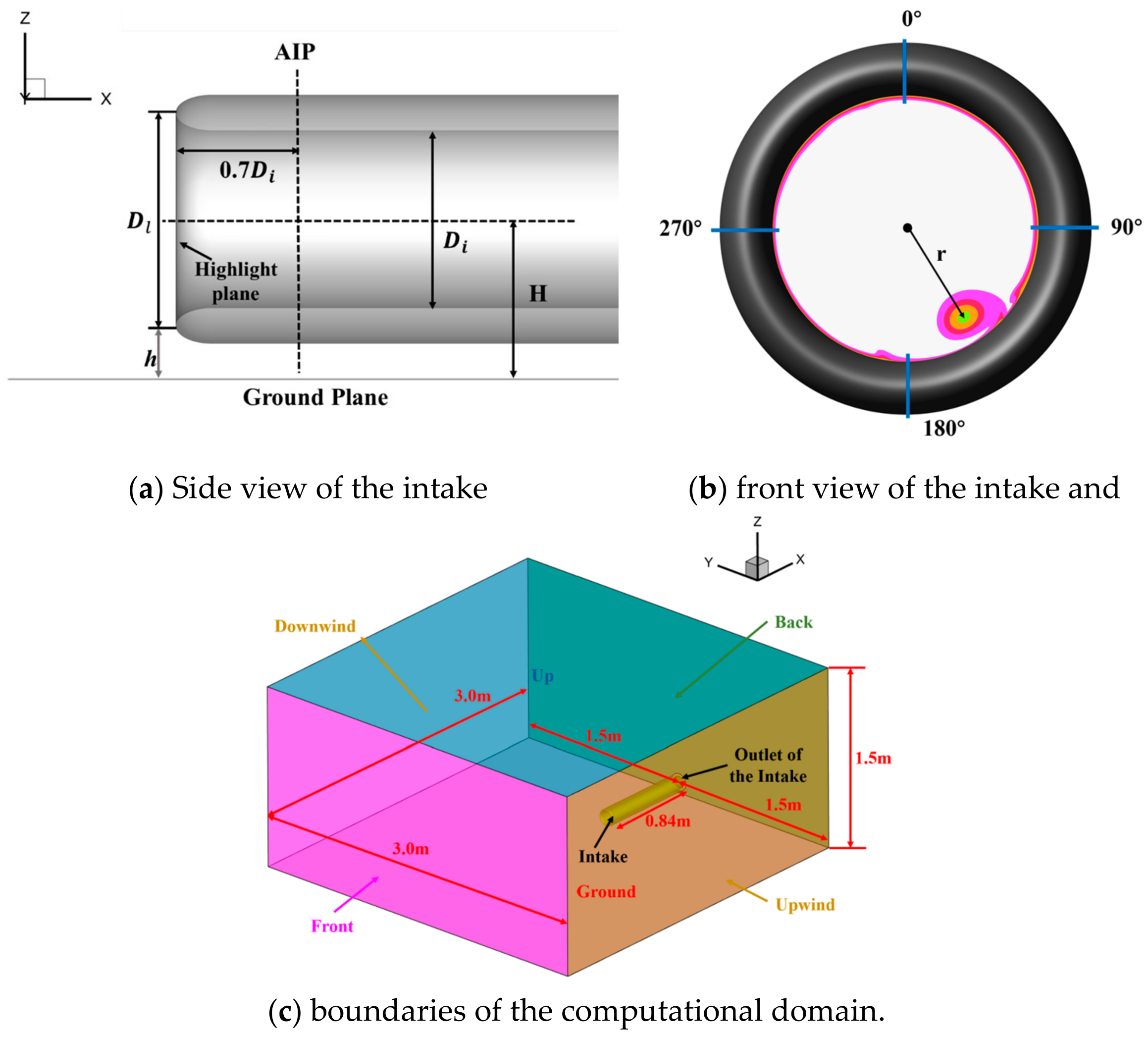
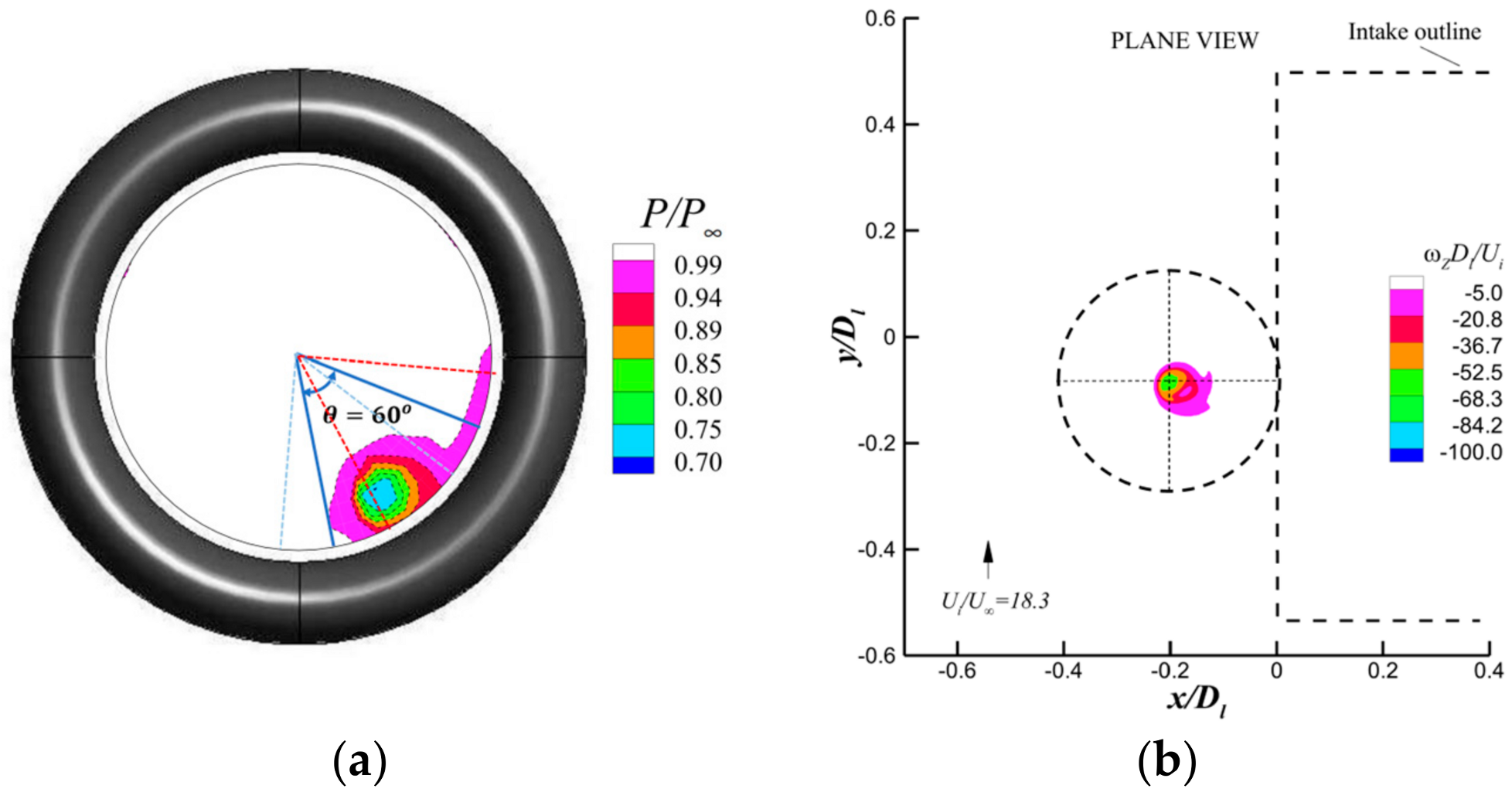
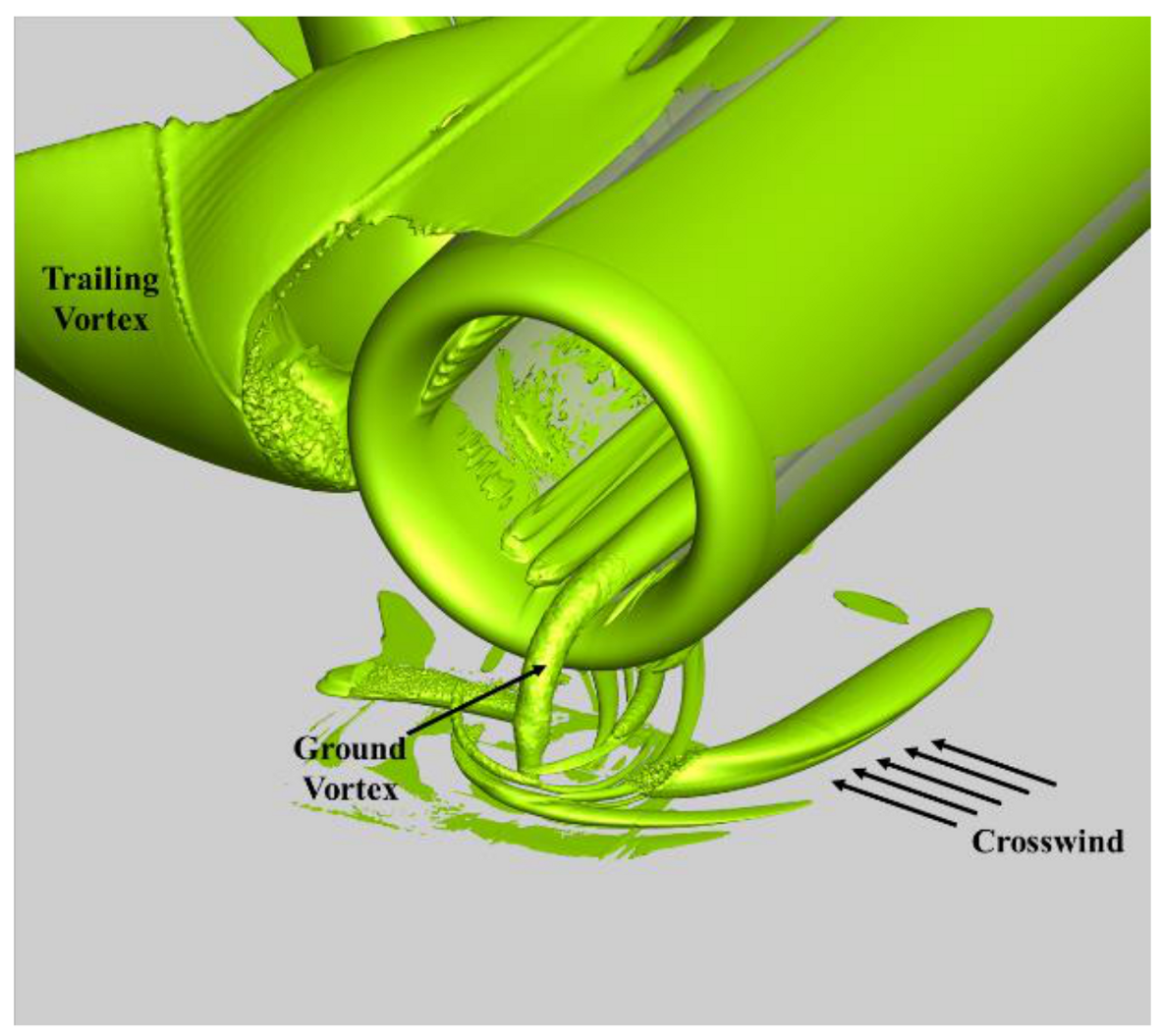
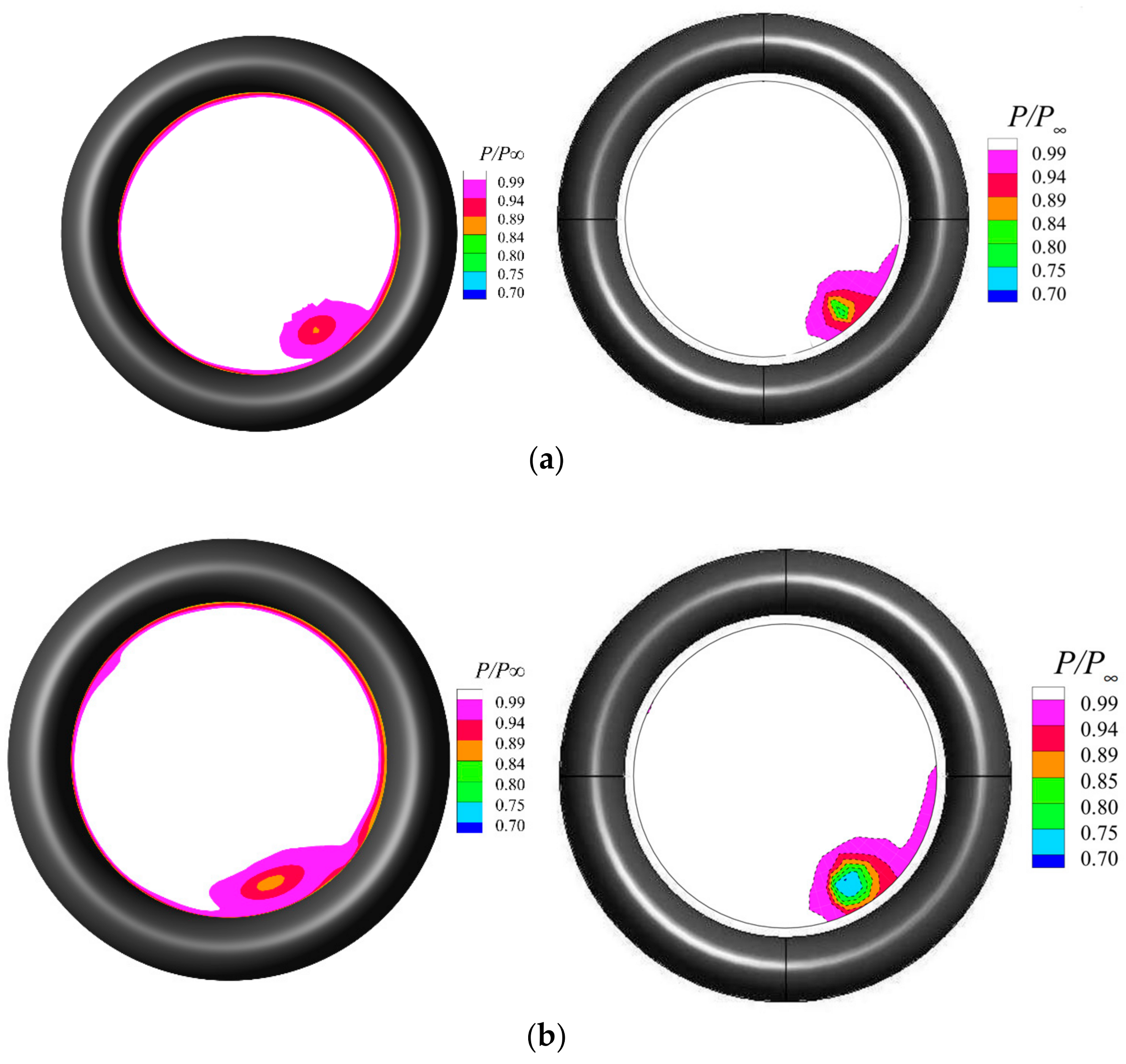

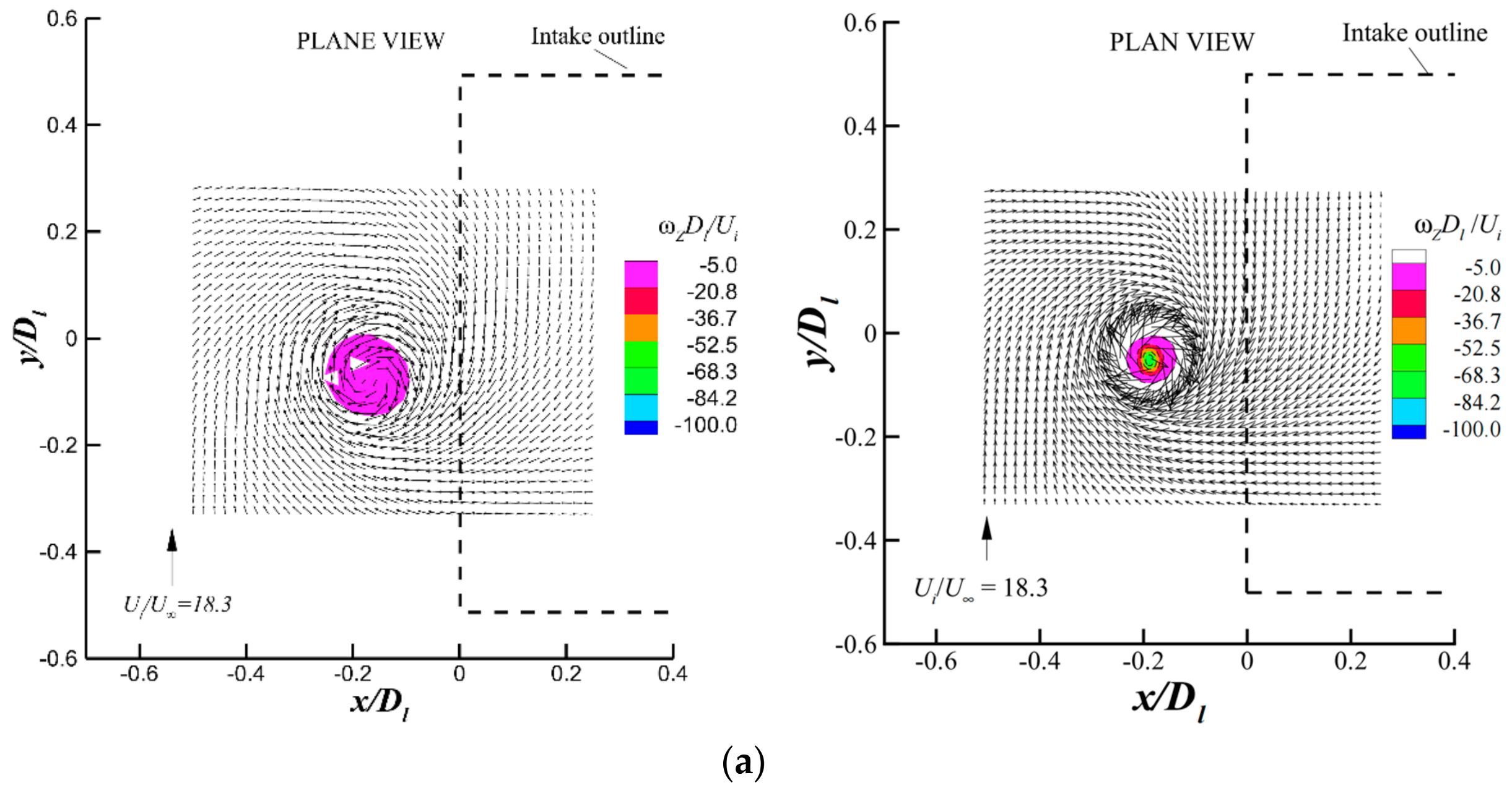
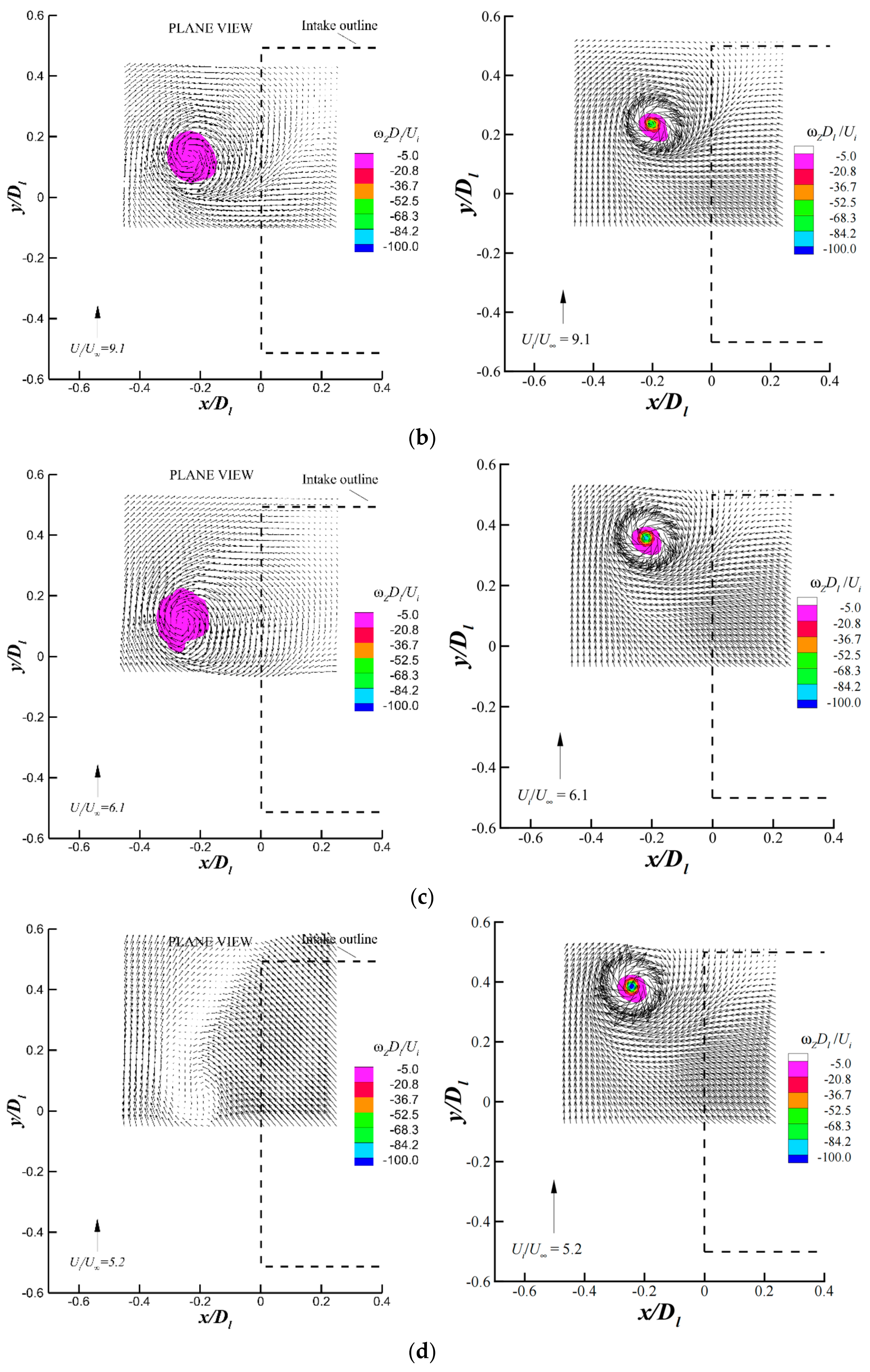

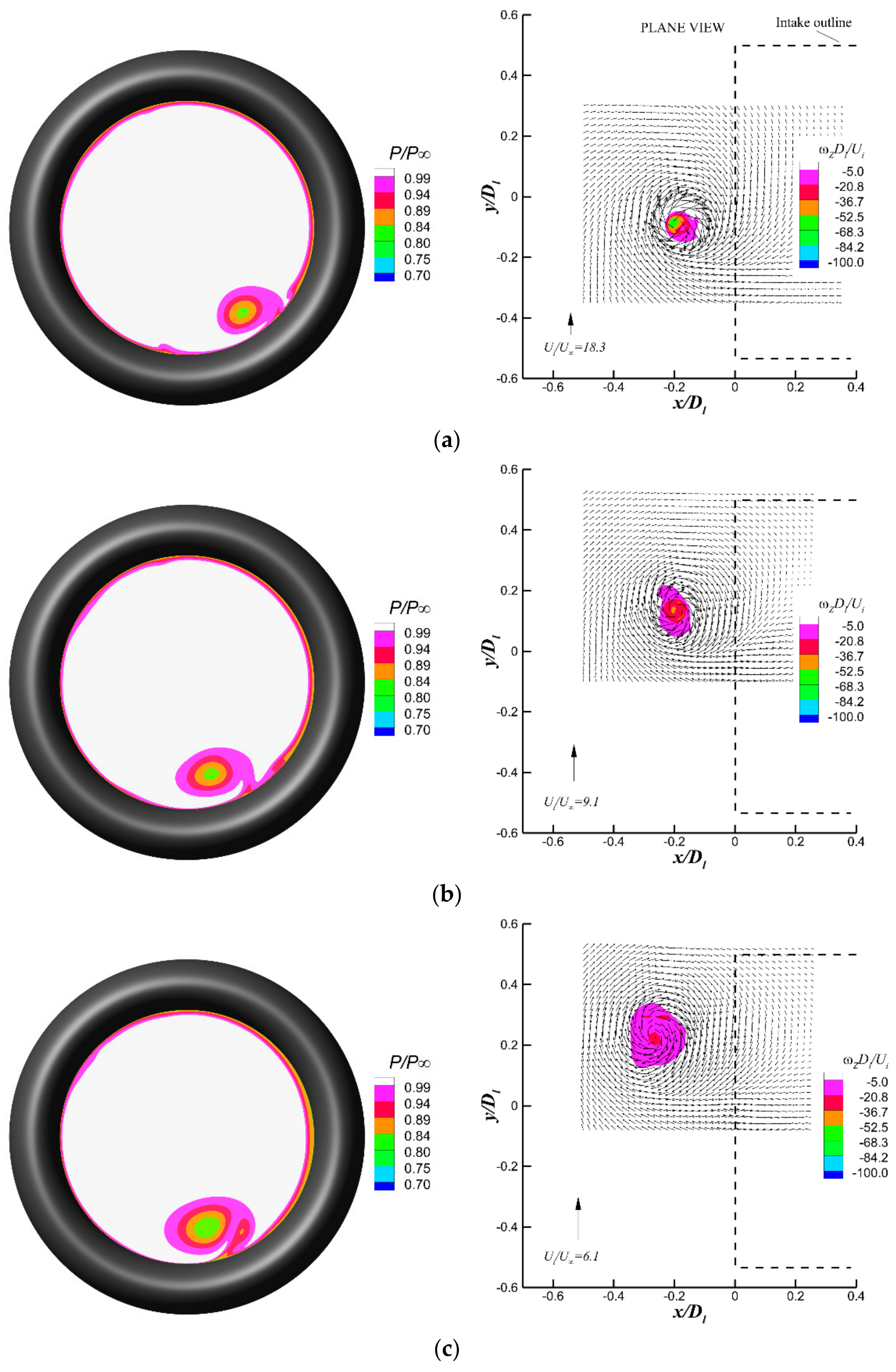

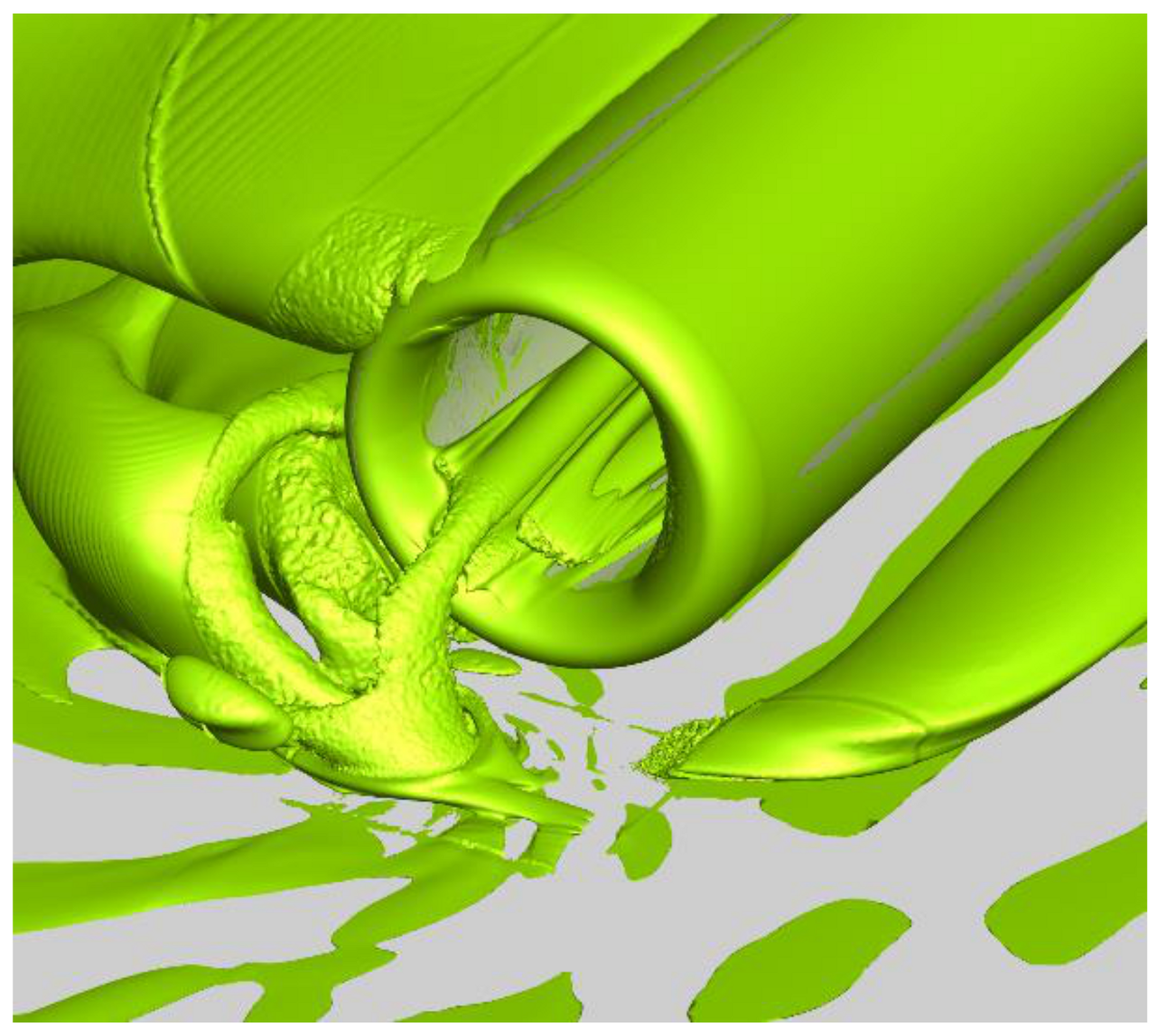
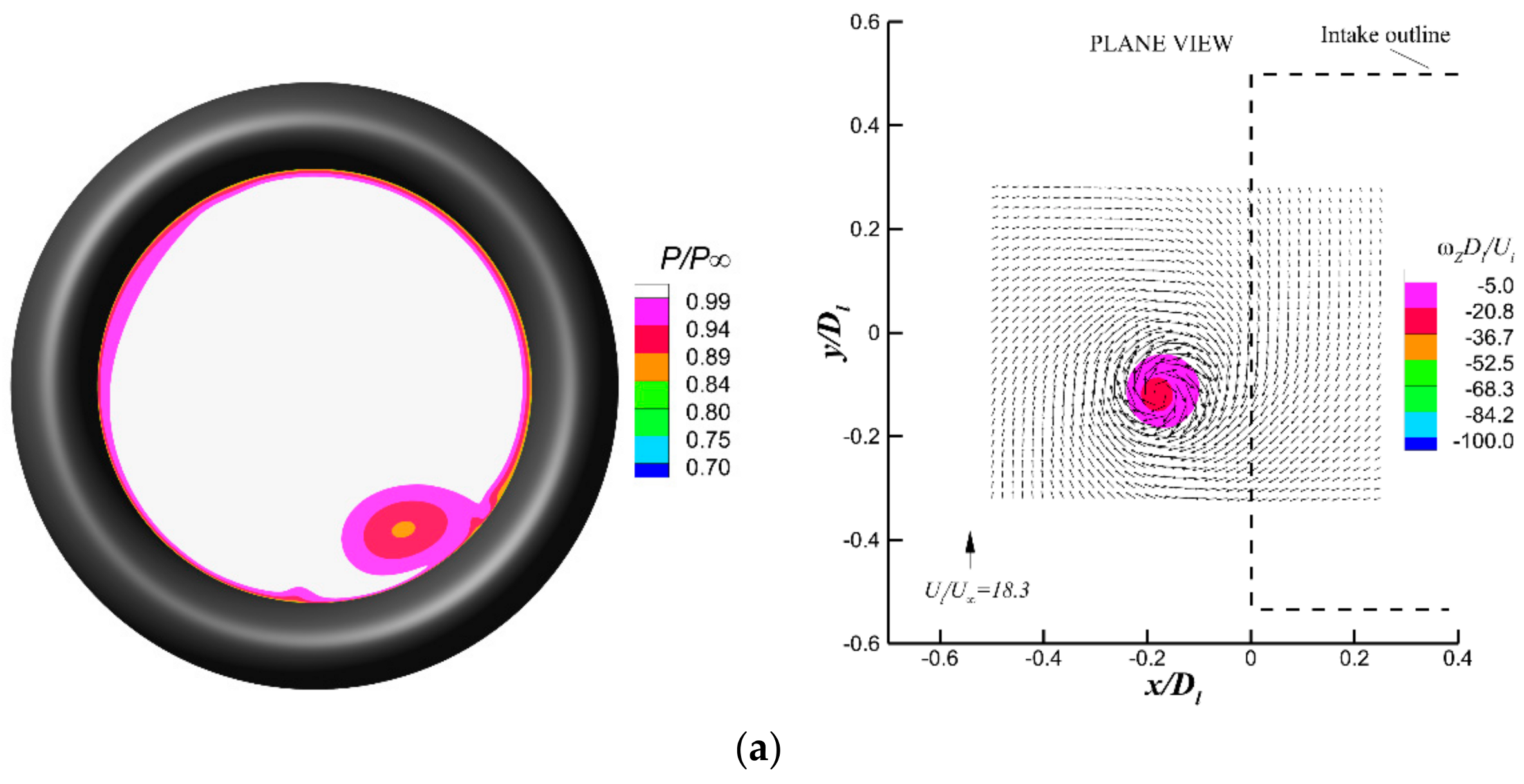
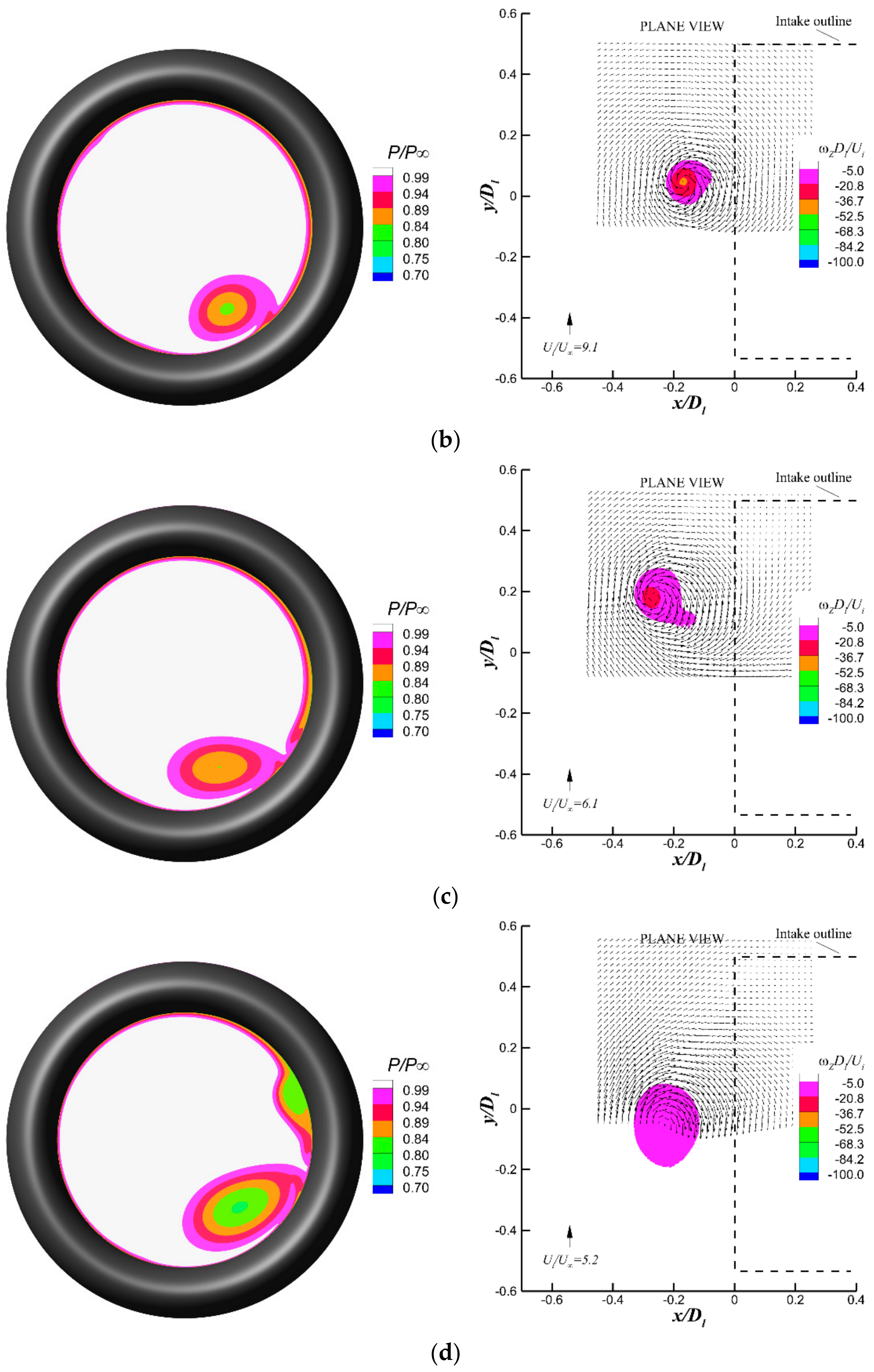

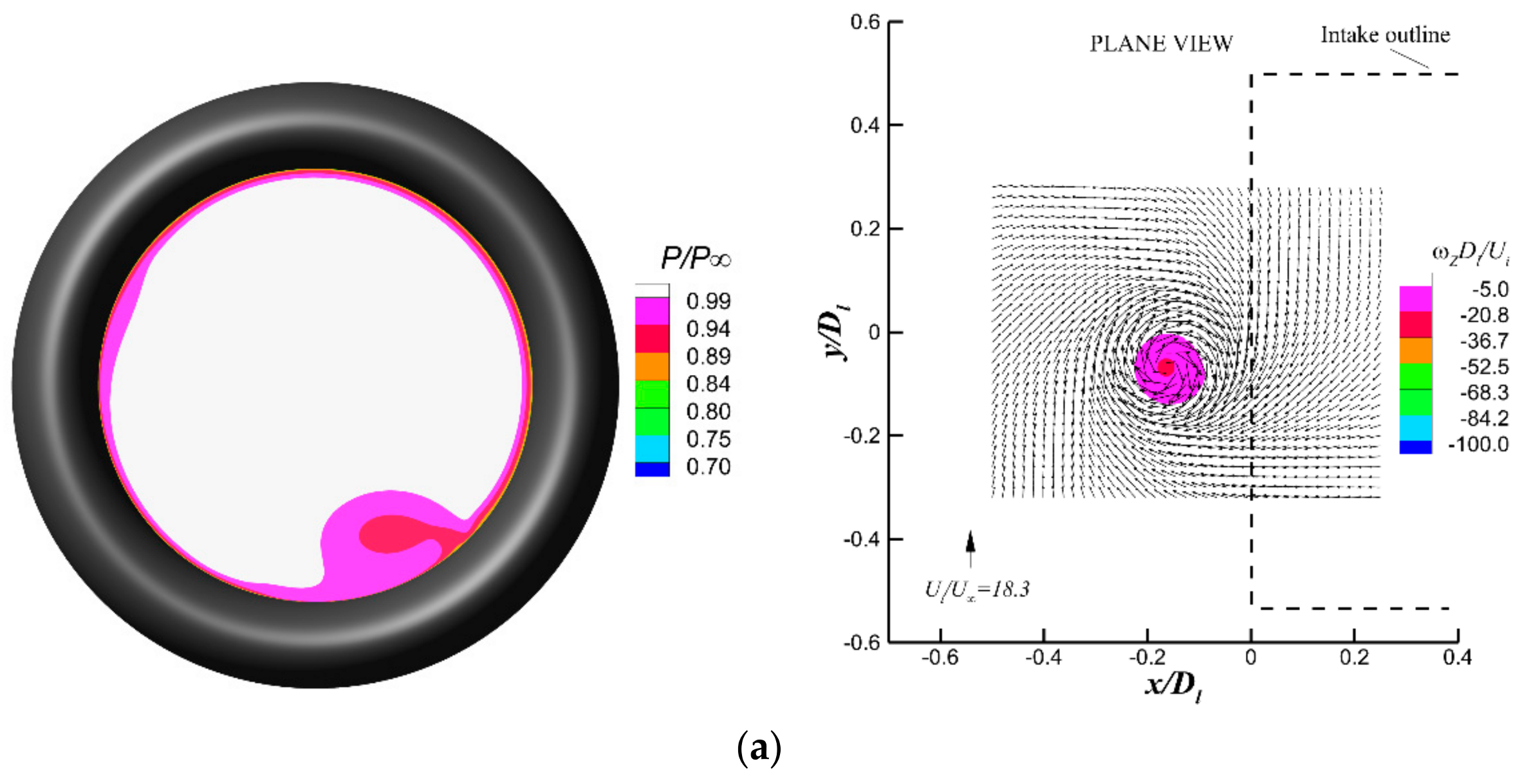

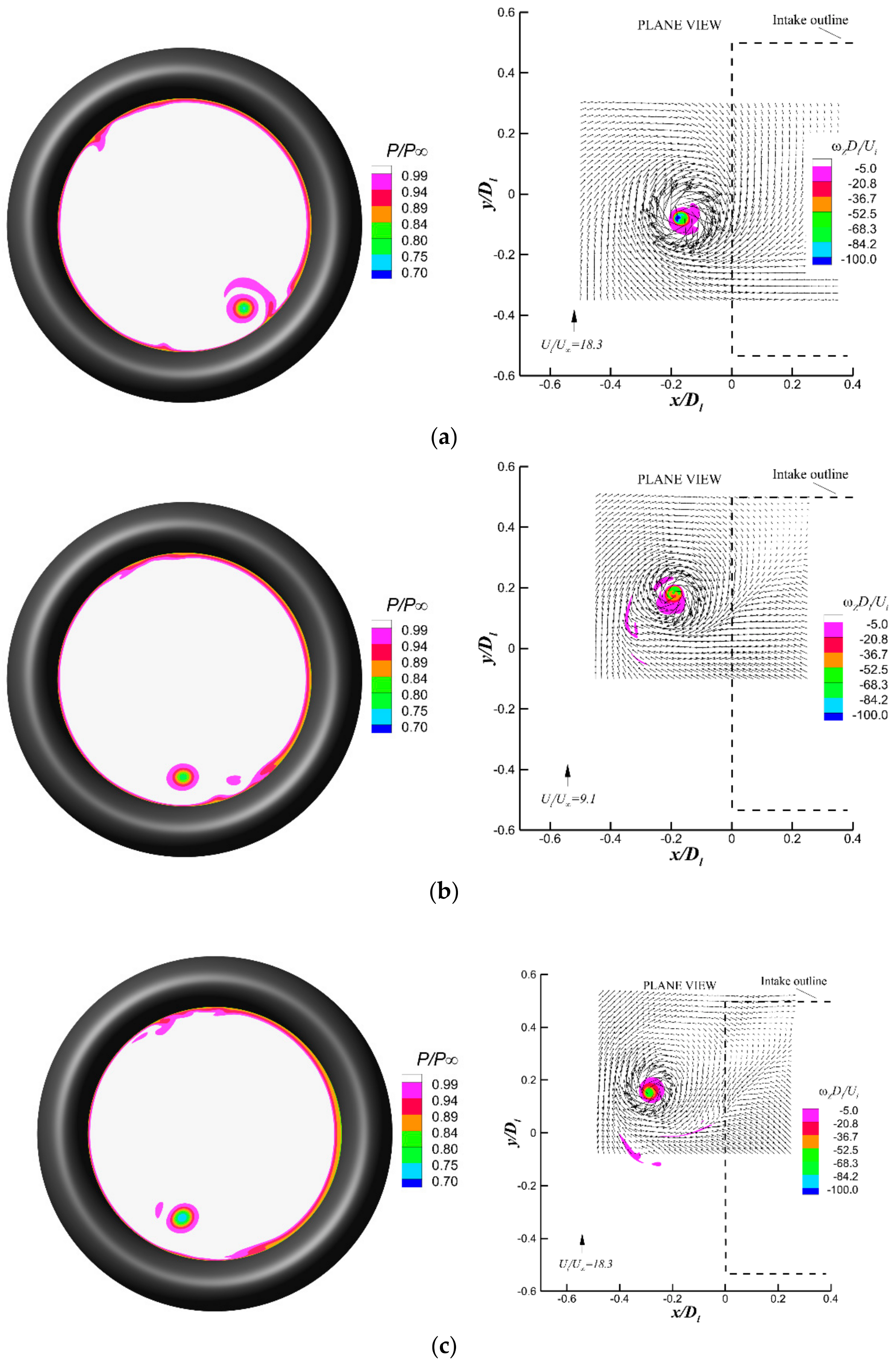

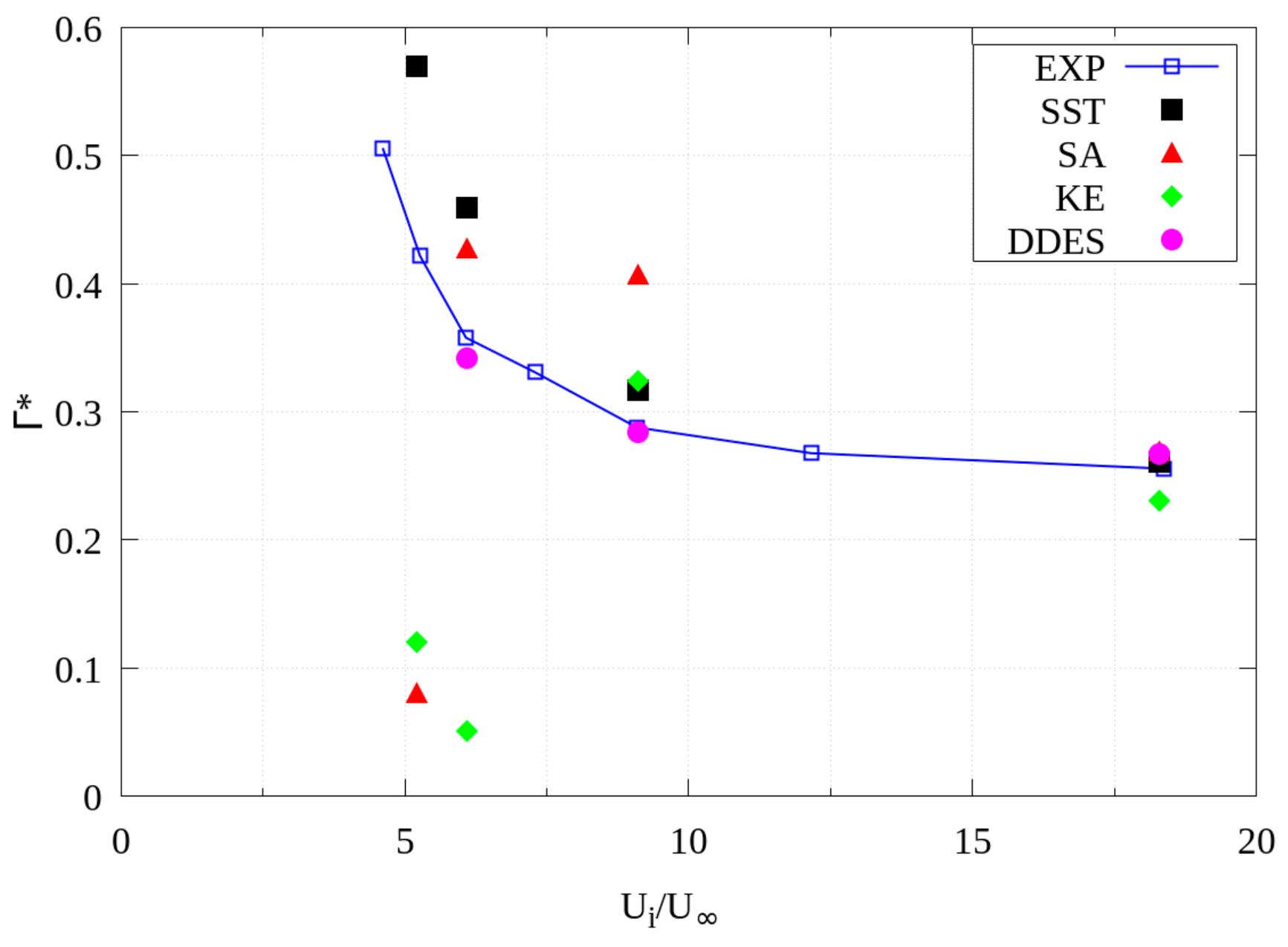
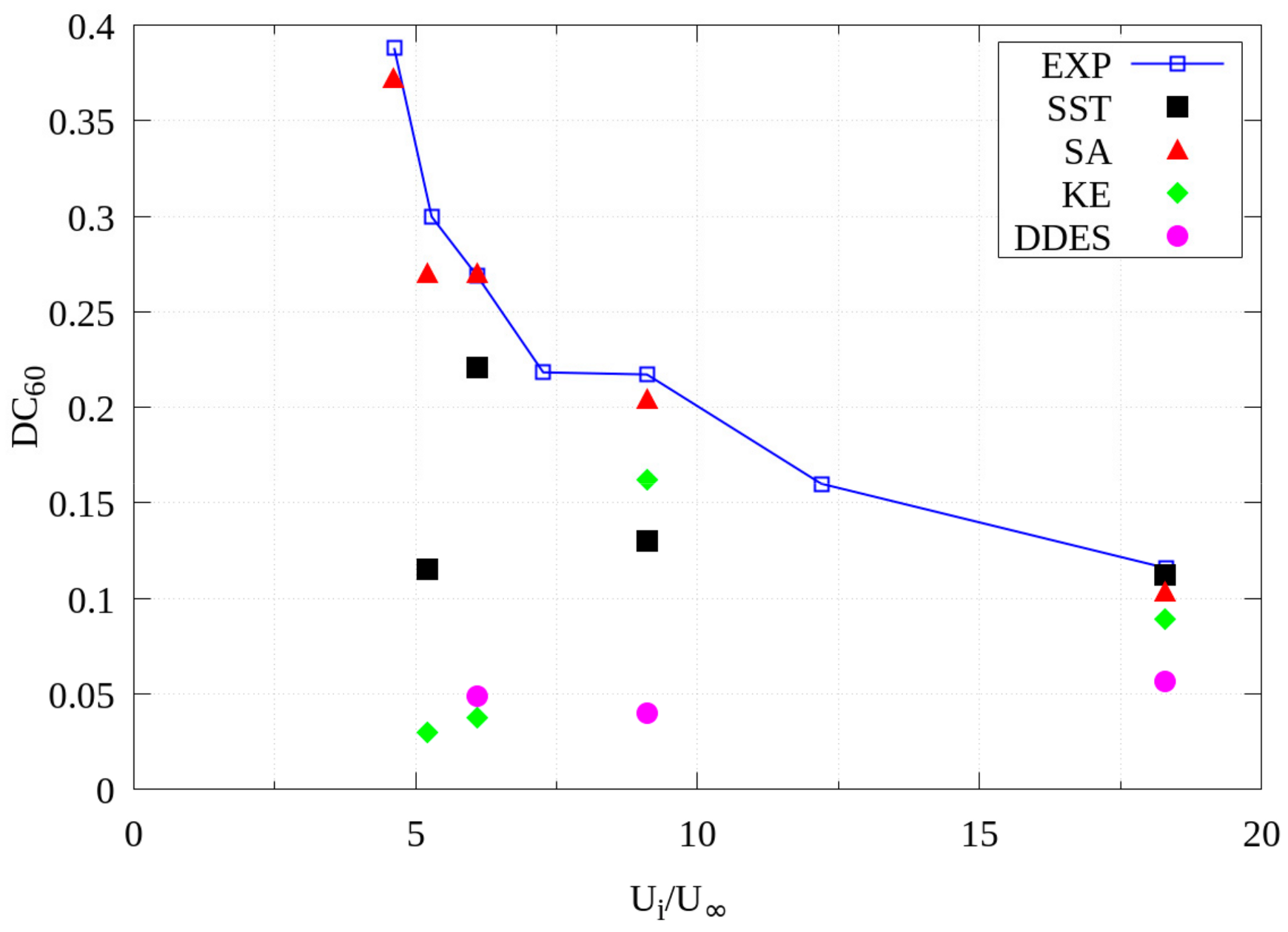

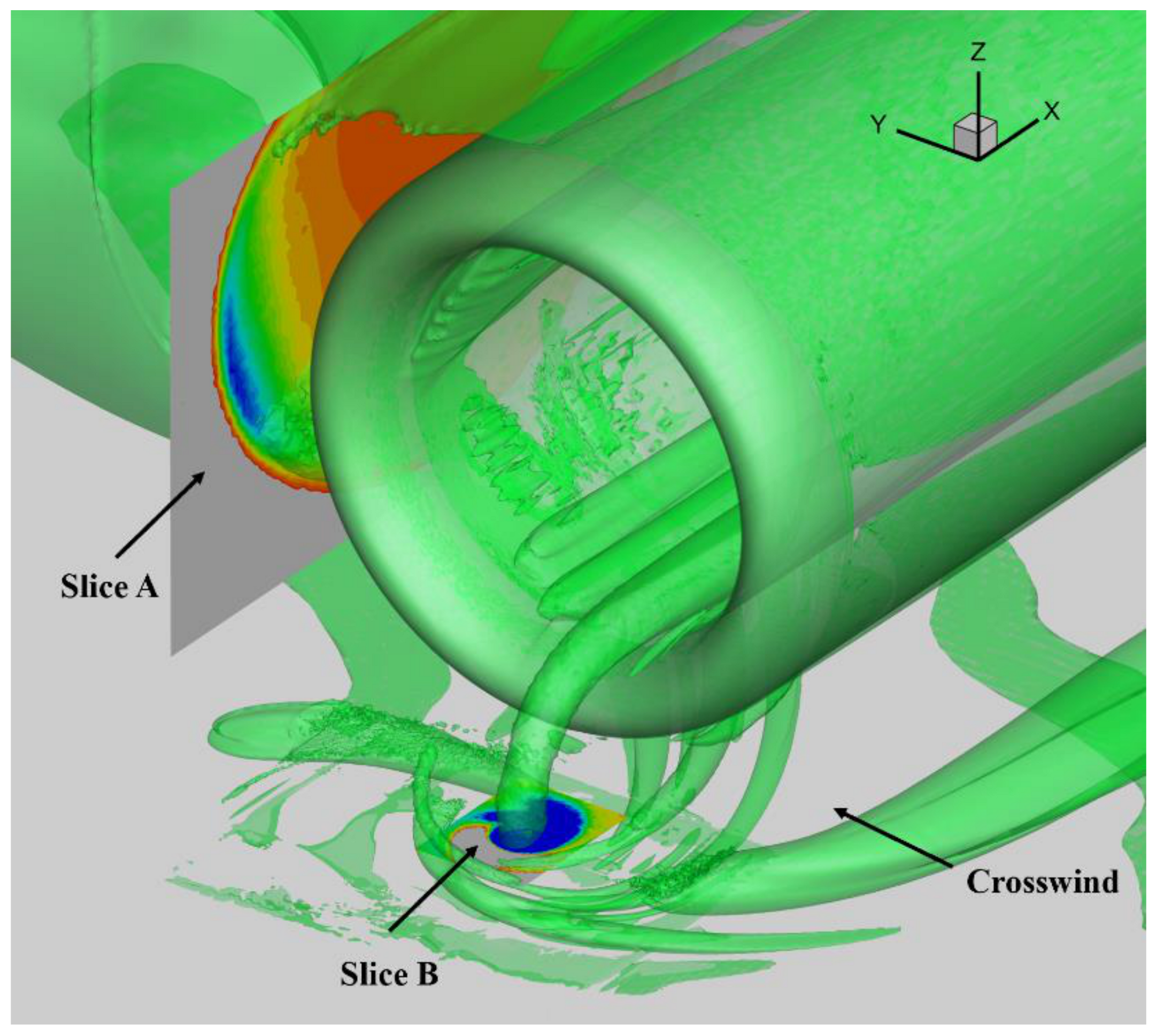



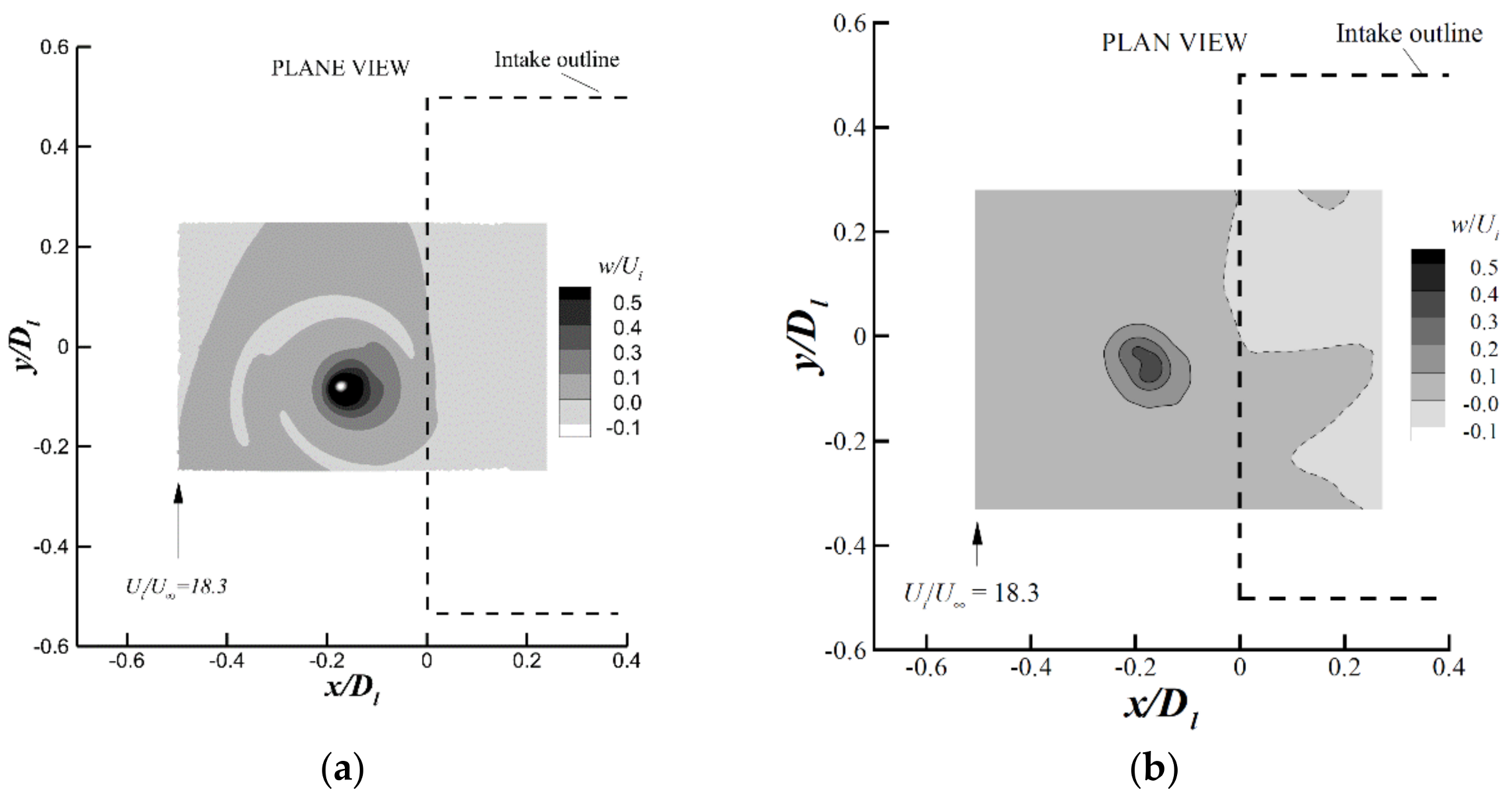
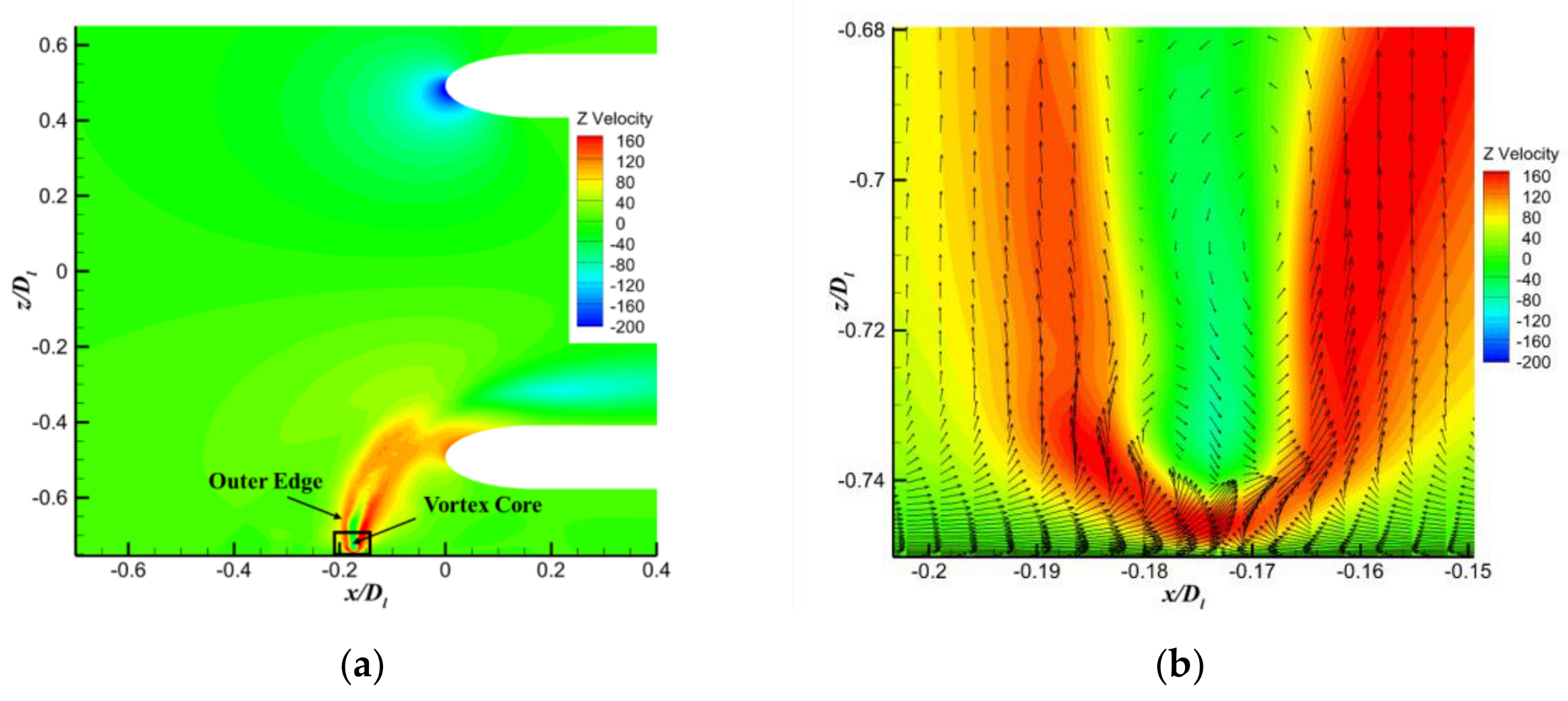

| Case | Pt (Pa) | Tt (K) | (m/s) | Ui/U∞ | |
|---|---|---|---|---|---|
| 1 | 100,880 | 290 | 9.92 | 18.3 | 1.46 |
| 2 | 100,910 | 290 | 20.0 | 9.1 | 1.46 |
| 3 | 100,970 | 290 | 30.2 | 6.1 | 1.46 |
| 4 | 101,000 | 290 | 35.4 | 5.2 | 1.46 |
| 5 | 101,000 | 290 | 39.0 | 4.6 | 1.43 |
| 6 | 101,000 | 290 | 45.0 | 4.0 | 1.42 |
| Turbulence Strength | 0.1% | 1.0% | 5.0% | 10.0% |
|---|---|---|---|---|
| DC60 | 0.102 | 0.085 | 0.094 | 0.08 |
| 0.296 | 0.292 | 0.284 | 0.289 |
| 0.12 | 0.45 | 1.03 | |
|---|---|---|---|
| DC60 | 0.0393 | 0.0407 | 0.0364 |
| 0.268 | 0.281 | 0.270 |
Disclaimer/Publisher’s Note: The statements, opinions and data contained in all publications are solely those of the individual author(s) and contributor(s) and not of MDPI and/or the editor(s). MDPI and/or the editor(s) disclaim responsibility for any injury to people or property resulting from any ideas, methods, instructions or products referred to in the content. |
© 2024 by the authors. Licensee MDPI, Basel, Switzerland. This article is an open access article distributed under the terms and conditions of the Creative Commons Attribution (CC BY) license (https://creativecommons.org/licenses/by/4.0/).
Share and Cite
Zhang, W.; Yang, T.; Shen, J.; Sun, Q. Lessons Learnt from the Simulations of Aero-Engine Ground Vortex. Aerospace 2024, 11, 699. https://doi.org/10.3390/aerospace11090699
Zhang W, Yang T, Shen J, Sun Q. Lessons Learnt from the Simulations of Aero-Engine Ground Vortex. Aerospace. 2024; 11(9):699. https://doi.org/10.3390/aerospace11090699
Chicago/Turabian StyleZhang, Wenqiang, Tao Yang, Jun Shen, and Qiangqiang Sun. 2024. "Lessons Learnt from the Simulations of Aero-Engine Ground Vortex" Aerospace 11, no. 9: 699. https://doi.org/10.3390/aerospace11090699






